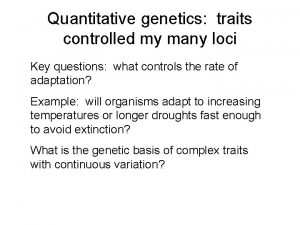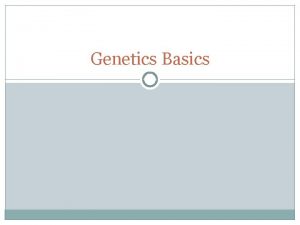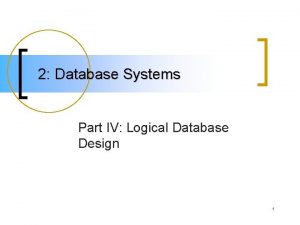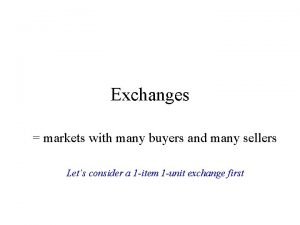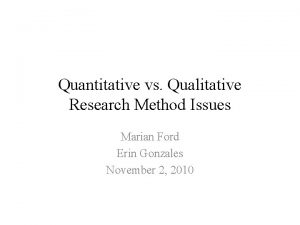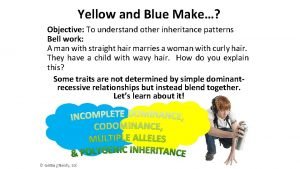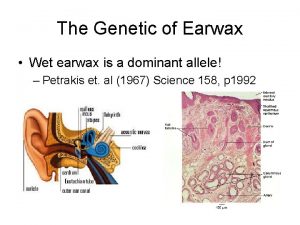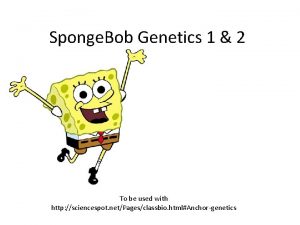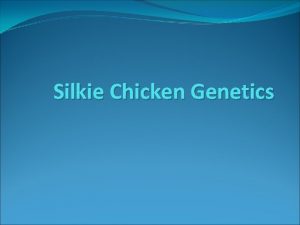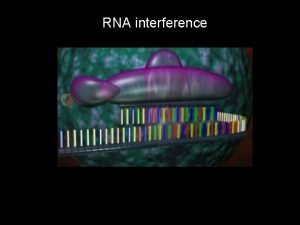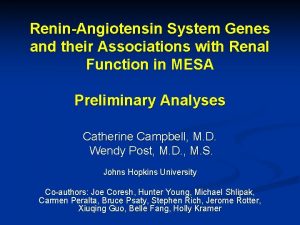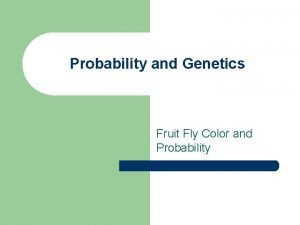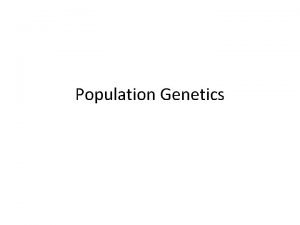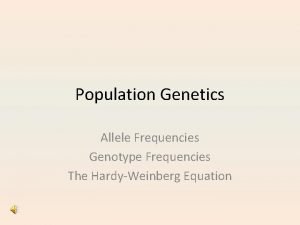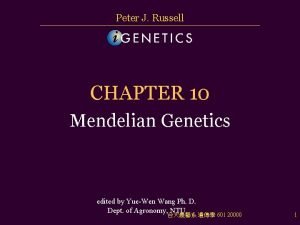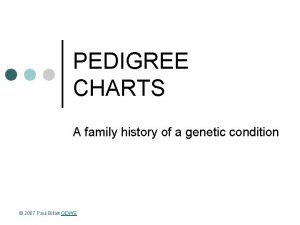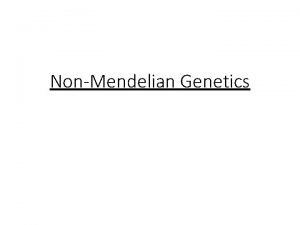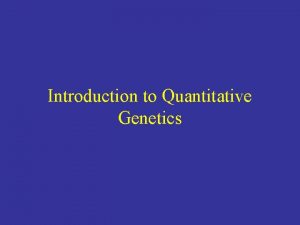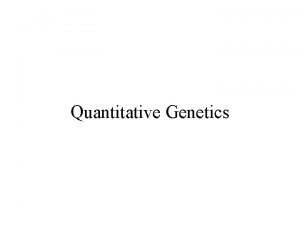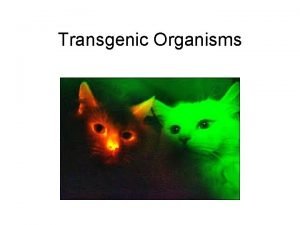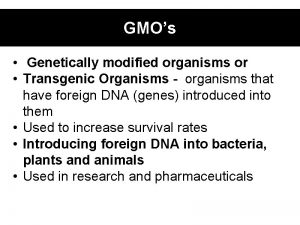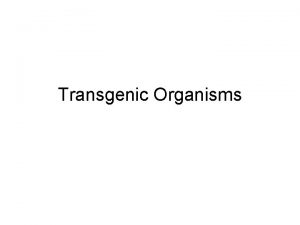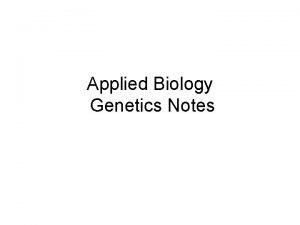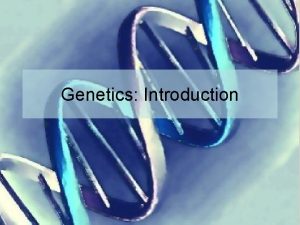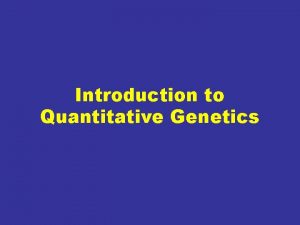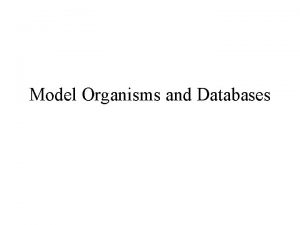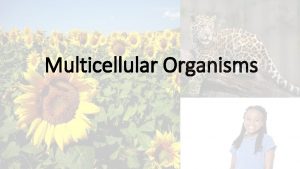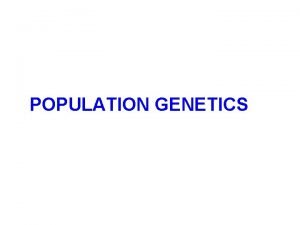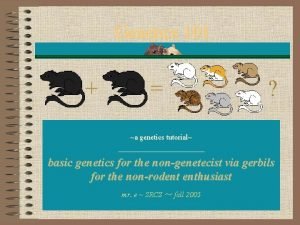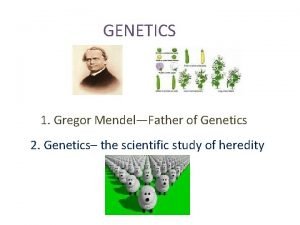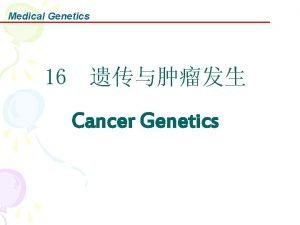Introduction to Quantitative Genetics Quantitative Characteristics Many organisms


































- Slides: 34

Introduction to Quantitative Genetics

Quantitative Characteristics ü Many organisms traits are genetically influenced, but do not show single-gene (Mendelian) patterns of inheritance. ü They are influenced by the combined action of many genes and are characterized by continuous variation. These are called polygenic traits. ü Continuously variable characteristics that are both polygenic and influenced by environmental factors are called multifactorial traits. Examples of quantitative characteristics

Types of Quantitative Traits 1. a continues measurement (quantity). 2. a countable meristic (measured in whole numbers). It can take on integer values only: For example, litter size. 3. a threshold characteristic which is either present or absent depending on the cumulative effect of a number of additive factors (diseases are often this type). It has an underlying quantitative distribution, but the trait only appears only if a threshold is crossed.

Types of Quantitative Trait In general, the distribution of quantitative traits values in a population follows the normal distribution (also known as Gaussian distribution or bell curve). These curves are characterized by the mean (mid-point) and by the variance (width). Often standard deviation, the square root of variance, is used as a measure of the curve’s width.

Principles of Quantitative Inheritance • Quantitative traits are influenced by the combined effects of numerous genes. These are called polygenic or multifactorial traits. • The genes follow Mendelian laws of inheritance; however, multifactorial traits have numerous possible phenotypic categories. • Environmental influences blur the phenotypic differences between adjacent genotypes.

As the number of loci affecting the trait increases, the # phenotypic categories increases. Number of phenotypic categories = (# gene pairs × 2) +1 Connecting the points of a frequency distribution creates a bell-shaped curve called a normal distribution.

Normal Distribution Standard Deviation Mean (average center of distribution) Mean +/- 1 s = 66% of values; +/- 2 s = over 95% of values

Quantitative Genetics not discrete • Continuous phenotypic variation within populations – Whole organism level • Causes of variation – Genes vs. environment – Interactions between genes and environment – Components of genetic variation – Components of environmental variation

Why is quantitative genetics important? Fisheries • Economically important traits = quantitative traits • Quantitative genetics theory -> basis for breeding programs • Environmental variation reduces efficiency of selection

Why is quantitative genetics important? Consequences of inbreeding and outcrossing • Fisheries – inbred lines, hybrids, F 1 s • Conservation – endangered species, captive breeding programs

Why is quantitative genetics important? Evolution • Natural selection requires heritable variation for traits

History Around 1900, there were two camps: • Biometricians – Continuous traits • Mendelians – Discrete traits Are discrete traits inherited in the same way as quantitative traits?

History Reconciliation: • Multiple loci (genes) contribute to variation! Is variation caused by a few loci of large effects or many loci with small effects?

Mathematical Basis of Quantitative Genetics • The basic premise of quantitative genetics: phenotype = genetics plus environment. P = G + E • In fact we are looking at variation in the traits, which is measured by the width of the Gaussian distribution curve. This width is the variance (or its square root, the standard deviation). • Variance is a useful property, because variances from different sources can be added together to get total variance.

Mathematical Basis of Quantitative Genetics • Quantitative traits can thus be expressed as: VT = VG + VE where VT = total variance, VG - variance due to genetics, and VE = variance due to environmental (noninherited) causes. • This equation is often written with an additional covariance term: the degree to which genetic and environmental variance

Heritability Measured using resemblance between relatives h 2 = genetic variation phenotypic variation Genetic + environmental + interaction

Heritability ü One property of interest is “heritability”, the proportion of a trait’s variation that is due to genetics (with the rest of it due to “environmental” factors). This seems like a simple concept, but it is loaded with problems. ü The broad-sense heritability, symbolized as H (sometimes H 2 to indicate that the units of variance are squared). H is a simple translation of the statement from above into mathematics: H = VG / VT ü This measure, the broad-sense heritability, is fairly easy to measure, especially in human populations where identical twins are available. However, different studies show wide variations in H values for the same traits, and plant breeders have found that it doesn’t accurately reflect the results of selection experiments. Thus, H is generally only used in social science

Heritability (broad-sense) is the proportion of a population’s phenotypic variance that is attributable to genetic differences

Genetic Variance ü The biggest problem with broad sense heritability comes from lumping all genetic phenomena into a single Vg factor. Paradoxically, not all variation due to genetic differences can be directly inherited by an offspring from the parents. ü Genetic variance can be split into 2 main components, additive genetic variance (VA) and dominance genetic variance (VD). VG = VA + VD ü Additive variance is the variance in a trait that is due to the effects of each individual allele being added together, without any interactions with other alleles or

Additive vs. Dominance Genetic Variance ü Dominance variance is the variance that is due to interactions between alleles: synergy, effects due to two alleles interacting to make the trait greater (or lesser) than the sum of the two alleles acting alone. We are using dominance variance to include both interactions between alleles of the same gene and interactions between difference genes, which is sometimes a separate component called epistasis variance. ü The important point: dominance variance is not directly inherited from parent to offspring. It is due to the interaction of genes from both parents within the individual, and of course only one allele is passed from

Heritability (narrow sense) is the proportion of a population’s phenotypic variance that is attributable to additive genetic variance as opposed to dominance genetic variance (interaction between alleles at the same locus). Additive genetic variance responds to selection

Narrow Sense Heritability ü For a practical breeder, dominance variance can’t be predicted, and it doesn’t affect the mean or variance of the offspring of a selection cross in a systematic fashion. Thus, only additive genetic variance is useful. Breeders and other scientists use “narrow sense heritability”, h, as a measure of heritability. h = VA / VT ü Narrow sense heritability can also be calculated directly from breeding experiments. For

The genetic Correlation Traits are not inherited as independent unit, but the several traits tend to be associated with each other This phenomenon can arise in 2 ways: 1. A subset of the genes that influence one trait may also influence another trait (pleiotropy) 2. The genes may act independently on the two traits, but due to non random mating, selection, or drift, they may be associated (linkage disequilibrium)

Basic formula: r. G = cov. XY / (var. X ∙ var. Y)0. 5 r. G often used both for additive (r. A) and genotypic (r. G) correlation! Phenotypic correlation: A combination of genetic and environmental (incl. nonadd gen effects) corr: r. P = h. X ∙ h. Y ∙ r. G + (1 -h 2 X)0. 5 ∙ (1 -h 2 Y)0. 5 ∙ r. E r. P = h. X ∙ h. Y ∙ r. G + e. X ∙ e. Y∙ r. E The magnitude and even the sign of r. G cannot be determined from r. P alone!

The use of genetic correlations 1. Trait-trait correlation Relation between different traits. For studies of how the improvement of one trait will affect another trait. 2. Age-age correlation Relation between a trait at young and mature age. Gives info about when reliable estimations can be achieved. 3. Site-site correlation Relation between genotype and environment. For deliniation of breeding and seed zones and for optimization of number of trials per zone Another basic use of r. G is prediction of genetic gain.

Two basic estimations of r. G • Burdon correlation, type A: Both traits are measured on the same individual (true genetic corr. ). Trait-trait and age-age correlations • Burdon correlation, type B: Two traits are measured on different individuals (approximated genetic corr. ). One trait expressed at two sites are considered as two different traits. Site-site correlations.

Some features of genetic correlations r. G = cov. XY / (var. X ∙ var. Y)0. 5 1) The three components are hard to estimate with any precision, i. e. large materials are needed. 2) Strongly influenced by gene frequencies, i. e. it is valid for a certain population only. Genetic correlations are easily changed by selection.

Type B correlations are routinely made by univariate methods Problems: 1) Correlation estimates are biased for unbalanced data and when variances across environments are heterogenous. 2) The estimates are frequently out of theoretical parameter space due to sampling errors of genetic variances and covariances (r. G > 1. 0). 3) The correlations are seldom normally distributed unless the test population is large. Standard error of genetic correlations are difficult to estimate and are often approximated! Estimates of standard error should be interpreted with caution. However they indicate the relatively

Correlated response If we select for character X, what will be the change of the correlated character Y? CRY = i ∙ h. X ∙ h. Y ∙ r. G ∙ σPY CRY = the correlated response in trait Y, i = the intensity of selection, h. X and h. Y = the square root of the h 2 r. G = the genetic correlation between traits X and Y σPY = the phenotypic standard deviation for trait Y. The CRY can be expressed in percent by relating it to the phenotypic mean of variable Y.

Indirect selection When character X will be improved, but select for another character (Y) and achieve progress due to the correlated response. CRX / RX = (i. Y ∙ r. A ∙ h. Y) / (i. X ∙ h. X) Presumptions: HY > HX and strong CR or i. Y > i. X. Usable when difficult to apply selection directly to the desired character: 1) Hard to measure with any precision, which reduces h 2 2) The desired trait is costly to measure. Then it would be better to select for an easily measurable, correlated

G x E interaction Parallell and no reaction norm Scale effects True interaction Both scale and true interaction

G x E interaction ü It is the ”true interactions” that should affect breeding strategies. ü Scale effects can be handled by transformation prior to analysis to ensure homogenity of among-genotype variances in environments. ü The question is whether breeding should be producing genotypes suitable for specific environments or genotypes adapted to a wide range of environments? ü G x E can be used in practice when interactions and the specific environments are well defined. üThe smaller G x E, the fewer test sites are needed.

Calculations of G x E 1. ANOVA according to the simple model: = G + E + G ∙ E. Y ü The model assumes homogenous variances between sites. Scale effects (not true interactions) will generate an interaction! ü Not independent of whether environment is a fixed or random effect.

2. G x E as genetic correlations: I. Yamada: r G= var. G / (var. G + var. I) var. G = genetic variance component from ANOVA involving data from two environments and var. I = G x E variance component from ANOVA. II. Burdon: r. G = r. XY / (h. X · h. Y) r. XY = phenotypic correlation between family means in environment X and Y h. X · h. Y = square roots of heritabilities of the genetic family means in environment X and Y. III. GCA-approach: r. G = r / (rax · ray) r = Pearson correlation between BLUP-values in environment X and Y
 Member of the same species
Member of the same species Unicellular vs multicellular activity
Unicellular vs multicellular activity Achillea millefolium
Achillea millefolium Figure 17-3 shows smaller and larger beaks
Figure 17-3 shows smaller and larger beaks Rr x rr
Rr x rr Plantae characteristics
Plantae characteristics Perfect competition 4 conditions
Perfect competition 4 conditions E r diagram
E r diagram Bookstore database design
Bookstore database design Erm and erd
Erm and erd Unary many to many
Unary many to many Erd ratio
Erd ratio Unary many to many
Unary many to many Many-to-many communication
Many-to-many communication Sqlbi many to many
Sqlbi many to many Unary many to many
Unary many to many Many sellers and many buyers
Many sellers and many buyers Scientific method example
Scientific method example Introduction in quantitative research
Introduction in quantitative research Example of paragraph
Example of paragraph The most common ridge characteristics
The most common ridge characteristics Getting nerdy llc genetics answer key
Getting nerdy llc genetics answer key Earwax type genetics
Earwax type genetics Susie roundpants
Susie roundpants Silkie chicken color genetics
Silkie chicken color genetics Sexual reproduction and genetics section 1 meiosis
Sexual reproduction and genetics section 1 meiosis %22ds-5%22%20development%20studio
%22ds-5%22%20development%20studio Genetics model
Genetics model Probability in genetics
Probability in genetics Learn.genetics.utah/content/addiction/mouse
Learn.genetics.utah/content/addiction/mouse What is fst
What is fst Allelic and genotypic frequencies
Allelic and genotypic frequencies Genetics branch diagram
Genetics branch diagram Pedigree key
Pedigree key Codominance example
Codominance example


